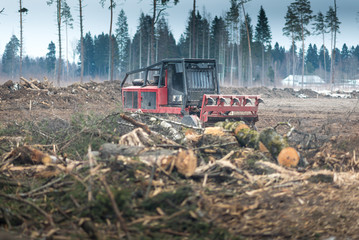Forestry Mulching is a process used to clear land. It can reduce the risk of wildfires. It also helps prevent weed growth and preserves topsoil. It is a highly efficient way to clear land. The following are some of the benefits of forest mulching. You should try it out if you want to reduce your carbon footprint. Tree Service operations in the past have involved bulldozers and excavators to remove undesired vegetation, underbrush, and trees.

Forestry mulching is a valuable tool in reducing the threat of wildfires in woodlands. It reduces the fuel in wooded areas and creates space for firebreaks in summer. It reduces the number of invasive plants and insects and helps prevent fungus and insect outbreaks.
Increasingly, forest managers are using mechanical fuel treatments to decrease the risk of wildfires in forests. These techniques have dramatically reduced wildfire hazards in the past decade. In addition to decreasing the risk of fire, they have improved the health of the forest. In particular, mulch treatments can reduce the number of trees per hectare and decrease the active crown fire risk.
Mulching also modifies soil temperature and improves soil moisture. In addition, it allows Douglas-fir seedlings to establish faster. As a result, they are more likely to grow to maturity and survive fires. Mulching also reduces evaporation, which increases soil moisture.
Forestry mulching is an efficient and proactive system for improving soil health and reducing the risk of wildfires. It helps keep the soil healthy by adding nutrients to the soil and preserving the topsoil. It also prevents erosion and helps protect tree roots from damage.
Forestry mulching is a cost-effective way to clear land. It has many advantages over traditional land clearing methods. For instance, it is much easier to manage, particularly for smaller parcels of land. It also saves on site prep and equipment costs, as it does not require multiple machines for felling, cutting, and hauling away vegetation. Plus, it uses less fuel and time than other methods.
Traditionally, land clearing involves hauling away the waste vegetation and debris, which adds to the costs. Forestry mulching eliminates the need for hauling away waste, vegetation and debris. But because hauling contractors do not know the exact amount of waste generated by each clearing operation, they can only provide a quote based on a “range” of potential loads. For example, they will usually quote the cost per cubic yard of waste based on the number of trees and stumps, so they can account for variations in the amount of material.
For a large-scale project, forestry mulching can be tedious and expensive. It takes a lot of time and material. Generally, the largest machines can only handle 25 tons of vegetation per acre. Besides, it takes more time than clearing a land by hand. It also requires road access for fuel and maintenance. There may be better options for remote locations.
Forestry Mulching is a method of covering a ground surface with wood chips, sawdust, or other shredded vegetation. The purpose of mulching is to prevent weed growth and maintain a healthy soil. It is also a good way to prevent evaporation, which lowers the need for irrigation. Mulches act as barriers against water, rain drops, and spores of different diseases. Mulches also help prevent weeds by blocking light from reaching them. In addition, mulches are known to produce heat, which also helps prevent weed growth.
Another important benefit of mulching is that it mimics the natural environment of forests, which is ideal for tree growth. The soil in an urban landscape has been altered by human activity, and adding a two to four-inch layer of mulch can recreate the soil environment of a forest.
Forestry mulching is a method of preserving topsoil, which can be applied in any weather. This method uses organic materials to cover the topsoil and preserve it from natural forces. It is a much quicker and less expensive method than traditional weed control techniques. It also requires no permits or other additional costs.
By protecting topsoil, it is possible to increase the productivity of your property. It also prevents soil erosion by protecting the soil from water runoff. Mulching is also beneficial in protecting the topsoil by reducing the moisture loss from the soil. The mulch layer also prevents the sun’s direct rays from reaching the topsoil, thereby limiting evaporation.
Forestry mulching is a simple and effective way to help trees flourish. It is an effective way to prevent and treat tree disease and insects that can harm their health. Trees can benefit from soil health treatments, which improve the soil’s overall health and help young plants establish in the soil.
